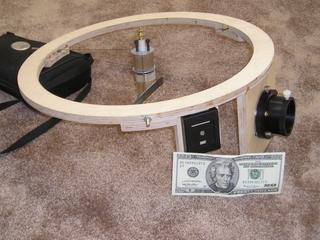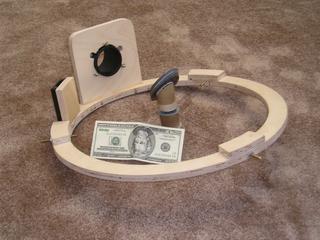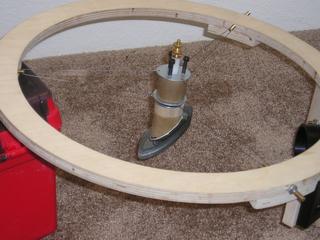My amateur telescope making page
The "Deep Space Scope" Design
Home | Astronomy | DS-3 | Secondary cage construction

Two views of the secondary cage, or ring. Inset picture, below - close-up of the secondary "cell".
Next, we need to create the secondary cage. Depending on how you look at it, weight in the secondary cage will either make your bearings larger, or force you into adding counter weight. See Bearings construction and mounting below for details on balancing the telescope. There is also some debate as to how far the eyepiece should be away from the secondary - should you bring it as close as possible, minimizing the size of the secondary, or should you use the focuser as part of your baffling system. I choose to get the focuser as close to the secondary as possible, but choose a focuser that will keep my eyepieces semi-baffled. Using NEWT, and taking vinyetting into account, I chose an uncluttered secondary ring diameter of 13". Add 1/4" for "stuff" that we will have invading the light path, and the secondary ring needs to be 13 1/2" in diameter.
- Create the secondary ring with the router. Outside cut first, 16" diameter. Inside cut next, 13 1/2" diameter.
- Make another small section of ring, same as above. Cut out 3 sections, 3" long. Glue these to the main ring, 120 degrees from each other. These sections hang DOWN, and are for ring strength where we attach the spider.
- If necessary, sand the ring.
- Drill 3 holes, 3/16" diameter, 120 degrees apart, through the secondary ring above where you glued the stiffeners.

- Create the spider. This is (from the top) a 1 1/2" washer with 7 holes, a 1" dowel 1" long with 4 holes, a 1 1/2" washer with 7 holes, a 1" washer with 1 hole, and a dowel 2" long. The dowel should be a hard wood, such as Oak. After cutting the 45 degree angle talked about in the next sentence, this dowel has an oversize hole in it, countersunk. Working from the bottom back up we have a center shaft that is a 1/8" brass threaded rod, 4 1/4" long. There is a small brass nut on the bottom, and a pretty brass nut on the top. The bottom dowel has a 45 degree cut in it. We will use double sided sticky tape to attach the secondary to this cut dowel. It then has a hole drilled through the center that is about 1 1/2 times the size of the center shaft. Drill ANOTHER hole part way through, right on top of the first hole, from the 45 degree diagonal size. This needs to be big enough that you can put a nut on the shaft, and have the nut sit inside of this hole. We will pull up against this nut, holding the whole thing together. Next up, we have a washer. Just keep the center hole. Next up, we have 3 machine screws pushing against this washer. These machine screws (Allen head screws) are 1/8" diameter, 2" long. We columnate the secondary through these three machine screws. Next up (after a quarter inch of air space), is one of the two 1 1/2" washers. These washers have 7 holes drilled into them. The hole in the center holds the brass threaded rod. Next out, there are 3 holes that fit the machine screws. These are 120 degrees from each other, and are about 1/3" out from the center. Next, as close to the edge as possible, we have 3 small holes that will be used to attach the wires of the spider. See the picture to the right if this isn't clear. Next up, we have three holes in the 1" dowel, lined up with the holes in the 1 1/2" washer. Make these holes one drill size smaller than the machine screws. That way, as they go into the dowel, they will cut their threads into the wood. On top of it all is a spacer and then a brass nut.
- We need 3 threaded shafts that attach to the ring. These shafts are threaded brass rods, 3/16" diameter, 2 1/2" long. Place these shafts on a piece of wood, and drill a 1/16" hole in them, 1/8" from the end. Now, lets thread the spider. Take a scrap piece of wood and drill a hole in it. Insert a long threaded bolt through the spider center. Attach this setup to the scrap of wood. Put a nail at the appropriate distance from the center, about 6 3/8". Thread the wire between the spider center, the nail, and back to the spider center. Be sure to include the threaded shafts that will attach to the secondary ring. Wrap this wire around itself three or four times for strength at the start and finish. Clip off the excess.
- Attach the spider to the secondary ring using three small nuts.
- Now, you have to guess (calculate) where the center of the secondary mirror will be. This will be a spot about 1.414 times the thickness of the mirror below the center of the 45 degree cut on the dowel. We want to have the focuser aimed at this spot.
- Make a 5 1/2" X 5 1/2" plywood mount for the focuser. Mount your focuser in the location that will have your eyepieces aimed at the imaginary spot mentioned above. This should be near the middle of this piece of plywood. Then, glue this piece to the secondary ring. To decide how far in towards the middle of the ring to glue this plate, you need to rack your focuser IN all the way. You then want it to stick into the secondary ring about 1/2". You may want to remove the focuser from the focuser plate before gluing the plywood in place.
- Make a finder mount. Mine, for a Quickfinder, is 2 1/2" X 2 3/4". On mine, I cut two vertical grooves in the wood, which keeps the Quickfinder from turning around on the center screw. Mount the Quickfinder to the wood to make sure that it works, then remove it again. Glue this piece in place. You want the inside of the wood to be flush with the INSIDE of the ring.
- Place the secondary mirror. First, mark the center of the back of the mirror. Next, the outline of the spider bottom (45 degree cut dowel) is marked on the mirror. Attach the secondary with DUCK brand double sided sticky tape.
- NOTE:I have had a secondary fall of it's holder using double sided tape. In the future, I will use silicone glue to attach the secondary.
- Cool - we now have a Deep Space spider!